Overrepresentation of Aboriginals in the Criminal Justice System
VerifiedAdded on 2022/08/16
|9
|2117
|17
AI Summary
Contribute Materials
Your contribution can guide someone’s learning journey. Share your
documents today.
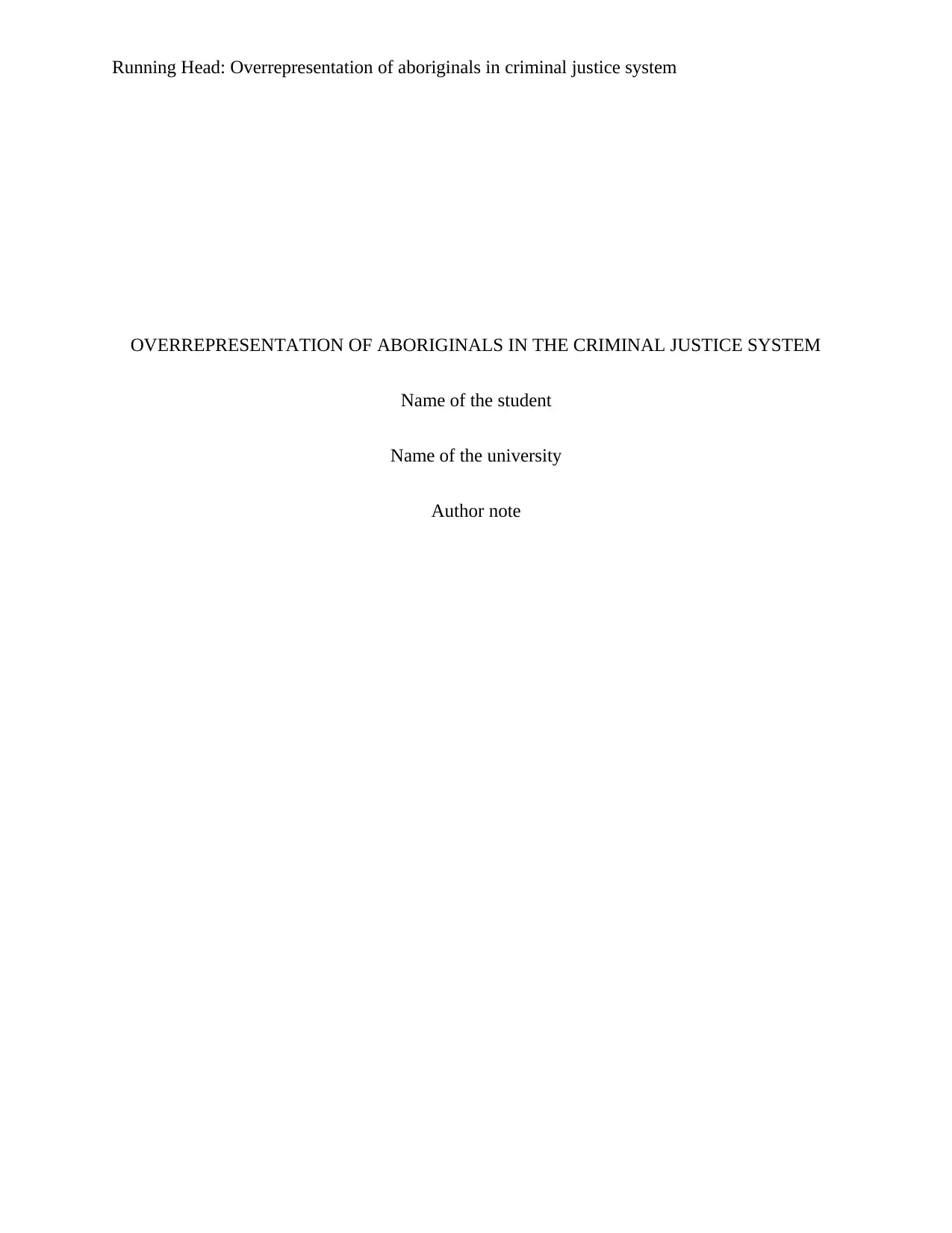
Running Head: Overrepresentation of aboriginals in criminal justice system
OVERREPRESENTATION OF ABORIGINALS IN THE CRIMINAL JUSTICE SYSTEM
Name of the student
Name of the university
Author note
OVERREPRESENTATION OF ABORIGINALS IN THE CRIMINAL JUSTICE SYSTEM
Name of the student
Name of the university
Author note
Secure Best Marks with AI Grader
Need help grading? Try our AI Grader for instant feedback on your assignments.
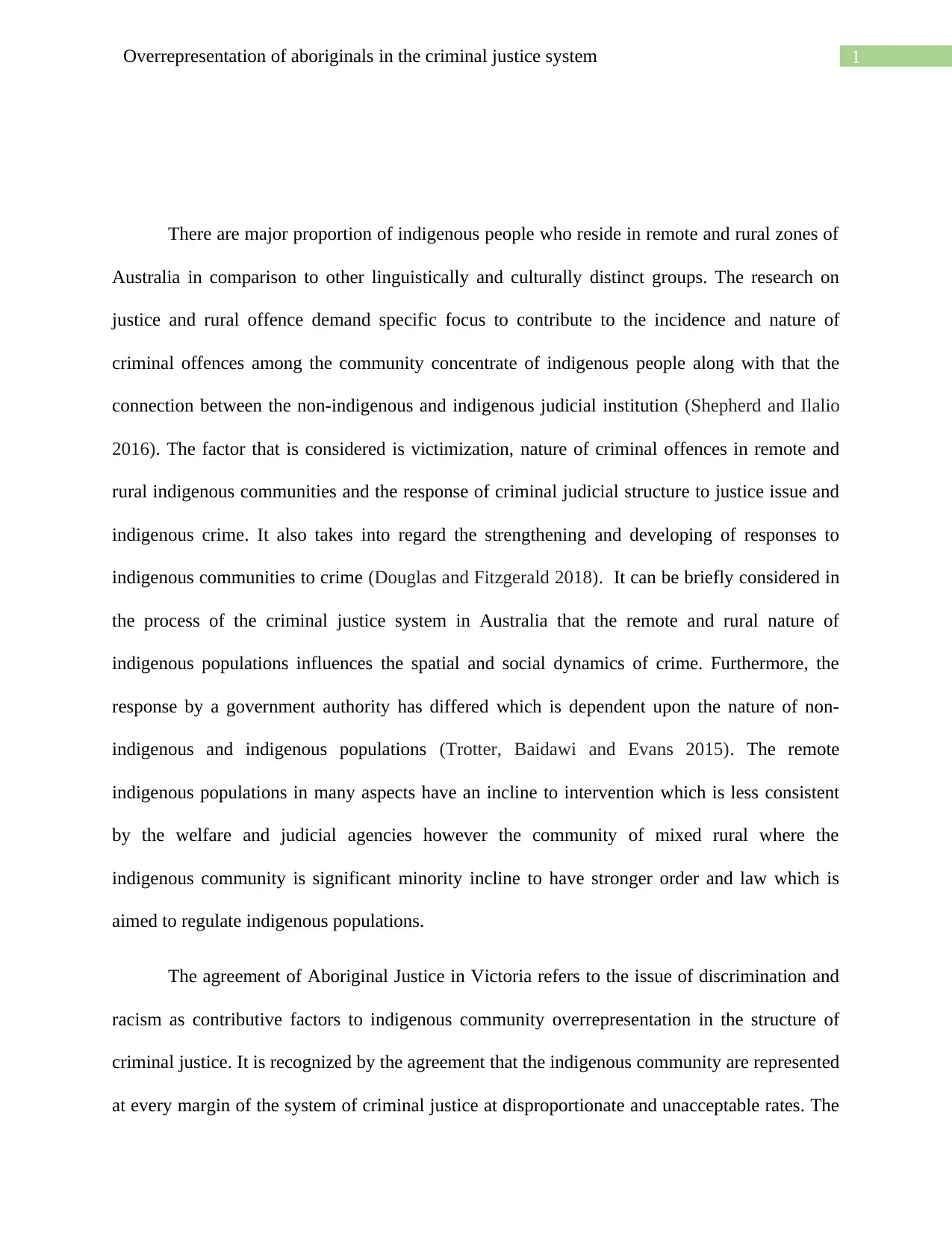
1Overrepresentation of aboriginals in the criminal justice system
There are major proportion of indigenous people who reside in remote and rural zones of
Australia in comparison to other linguistically and culturally distinct groups. The research on
justice and rural offence demand specific focus to contribute to the incidence and nature of
criminal offences among the community concentrate of indigenous people along with that the
connection between the non-indigenous and indigenous judicial institution (Shepherd and Ilalio
2016). The factor that is considered is victimization, nature of criminal offences in remote and
rural indigenous communities and the response of criminal judicial structure to justice issue and
indigenous crime. It also takes into regard the strengthening and developing of responses to
indigenous communities to crime (Douglas and Fitzgerald 2018). It can be briefly considered in
the process of the criminal justice system in Australia that the remote and rural nature of
indigenous populations influences the spatial and social dynamics of crime. Furthermore, the
response by a government authority has differed which is dependent upon the nature of non-
indigenous and indigenous populations (Trotter, Baidawi and Evans 2015). The remote
indigenous populations in many aspects have an incline to intervention which is less consistent
by the welfare and judicial agencies however the community of mixed rural where the
indigenous community is significant minority incline to have stronger order and law which is
aimed to regulate indigenous populations.
The agreement of Aboriginal Justice in Victoria refers to the issue of discrimination and
racism as contributive factors to indigenous community overrepresentation in the structure of
criminal justice. It is recognized by the agreement that the indigenous community are represented
at every margin of the system of criminal justice at disproportionate and unacceptable rates. The
There are major proportion of indigenous people who reside in remote and rural zones of
Australia in comparison to other linguistically and culturally distinct groups. The research on
justice and rural offence demand specific focus to contribute to the incidence and nature of
criminal offences among the community concentrate of indigenous people along with that the
connection between the non-indigenous and indigenous judicial institution (Shepherd and Ilalio
2016). The factor that is considered is victimization, nature of criminal offences in remote and
rural indigenous communities and the response of criminal judicial structure to justice issue and
indigenous crime. It also takes into regard the strengthening and developing of responses to
indigenous communities to crime (Douglas and Fitzgerald 2018). It can be briefly considered in
the process of the criminal justice system in Australia that the remote and rural nature of
indigenous populations influences the spatial and social dynamics of crime. Furthermore, the
response by a government authority has differed which is dependent upon the nature of non-
indigenous and indigenous populations (Trotter, Baidawi and Evans 2015). The remote
indigenous populations in many aspects have an incline to intervention which is less consistent
by the welfare and judicial agencies however the community of mixed rural where the
indigenous community is significant minority incline to have stronger order and law which is
aimed to regulate indigenous populations.
The agreement of Aboriginal Justice in Victoria refers to the issue of discrimination and
racism as contributive factors to indigenous community overrepresentation in the structure of
criminal justice. It is recognized by the agreement that the indigenous community are represented
at every margin of the system of criminal justice at disproportionate and unacceptable rates. The
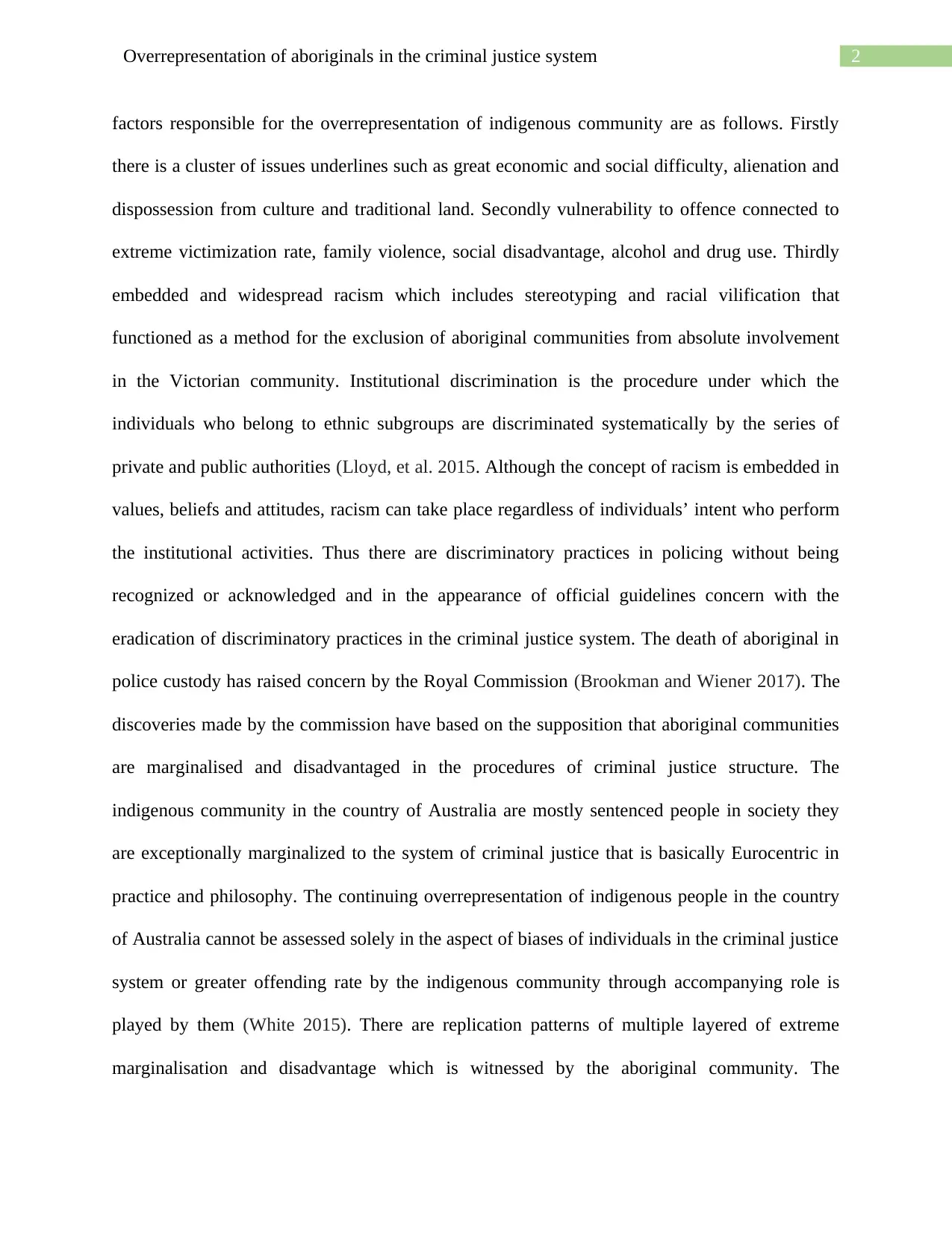
2Overrepresentation of aboriginals in the criminal justice system
factors responsible for the overrepresentation of indigenous community are as follows. Firstly
there is a cluster of issues underlines such as great economic and social difficulty, alienation and
dispossession from culture and traditional land. Secondly vulnerability to offence connected to
extreme victimization rate, family violence, social disadvantage, alcohol and drug use. Thirdly
embedded and widespread racism which includes stereotyping and racial vilification that
functioned as a method for the exclusion of aboriginal communities from absolute involvement
in the Victorian community. Institutional discrimination is the procedure under which the
individuals who belong to ethnic subgroups are discriminated systematically by the series of
private and public authorities (Lloyd, et al. 2015. Although the concept of racism is embedded in
values, beliefs and attitudes, racism can take place regardless of individuals’ intent who perform
the institutional activities. Thus there are discriminatory practices in policing without being
recognized or acknowledged and in the appearance of official guidelines concern with the
eradication of discriminatory practices in the criminal justice system. The death of aboriginal in
police custody has raised concern by the Royal Commission (Brookman and Wiener 2017). The
discoveries made by the commission have based on the supposition that aboriginal communities
are marginalised and disadvantaged in the procedures of criminal justice structure. The
indigenous community in the country of Australia are mostly sentenced people in society they
are exceptionally marginalized to the system of criminal justice that is basically Eurocentric in
practice and philosophy. The continuing overrepresentation of indigenous people in the country
of Australia cannot be assessed solely in the aspect of biases of individuals in the criminal justice
system or greater offending rate by the indigenous community through accompanying role is
played by them (White 2015). There are replication patterns of multiple layered of extreme
marginalisation and disadvantage which is witnessed by the aboriginal community. The
factors responsible for the overrepresentation of indigenous community are as follows. Firstly
there is a cluster of issues underlines such as great economic and social difficulty, alienation and
dispossession from culture and traditional land. Secondly vulnerability to offence connected to
extreme victimization rate, family violence, social disadvantage, alcohol and drug use. Thirdly
embedded and widespread racism which includes stereotyping and racial vilification that
functioned as a method for the exclusion of aboriginal communities from absolute involvement
in the Victorian community. Institutional discrimination is the procedure under which the
individuals who belong to ethnic subgroups are discriminated systematically by the series of
private and public authorities (Lloyd, et al. 2015. Although the concept of racism is embedded in
values, beliefs and attitudes, racism can take place regardless of individuals’ intent who perform
the institutional activities. Thus there are discriminatory practices in policing without being
recognized or acknowledged and in the appearance of official guidelines concern with the
eradication of discriminatory practices in the criminal justice system. The death of aboriginal in
police custody has raised concern by the Royal Commission (Brookman and Wiener 2017). The
discoveries made by the commission have based on the supposition that aboriginal communities
are marginalised and disadvantaged in the procedures of criminal justice structure. The
indigenous community in the country of Australia are mostly sentenced people in society they
are exceptionally marginalized to the system of criminal justice that is basically Eurocentric in
practice and philosophy. The continuing overrepresentation of indigenous people in the country
of Australia cannot be assessed solely in the aspect of biases of individuals in the criminal justice
system or greater offending rate by the indigenous community through accompanying role is
played by them (White 2015). There are replication patterns of multiple layered of extreme
marginalisation and disadvantage which is witnessed by the aboriginal community. The
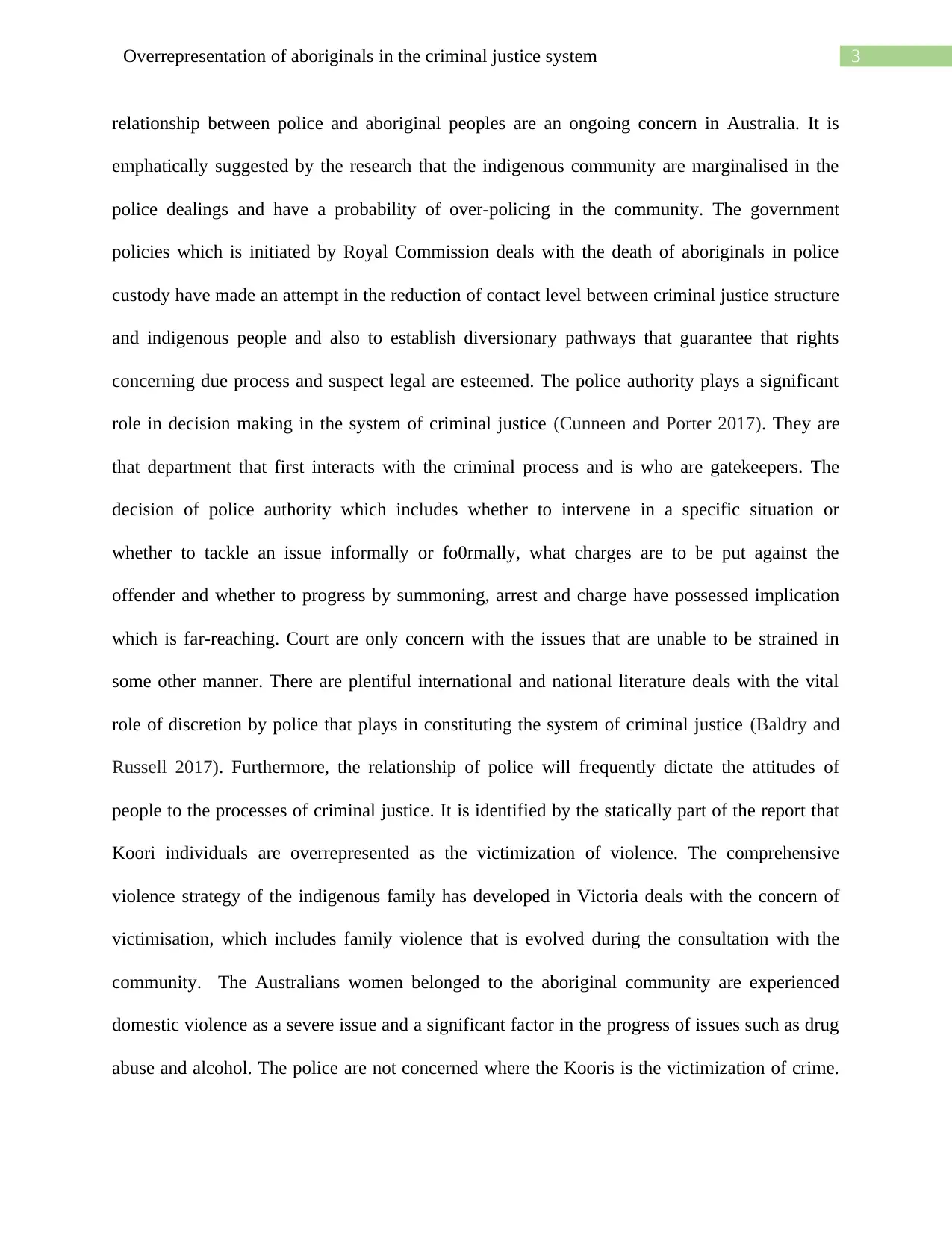
3Overrepresentation of aboriginals in the criminal justice system
relationship between police and aboriginal peoples are an ongoing concern in Australia. It is
emphatically suggested by the research that the indigenous community are marginalised in the
police dealings and have a probability of over-policing in the community. The government
policies which is initiated by Royal Commission deals with the death of aboriginals in police
custody have made an attempt in the reduction of contact level between criminal justice structure
and indigenous people and also to establish diversionary pathways that guarantee that rights
concerning due process and suspect legal are esteemed. The police authority plays a significant
role in decision making in the system of criminal justice (Cunneen and Porter 2017). They are
that department that first interacts with the criminal process and is who are gatekeepers. The
decision of police authority which includes whether to intervene in a specific situation or
whether to tackle an issue informally or fo0rmally, what charges are to be put against the
offender and whether to progress by summoning, arrest and charge have possessed implication
which is far-reaching. Court are only concern with the issues that are unable to be strained in
some other manner. There are plentiful international and national literature deals with the vital
role of discretion by police that plays in constituting the system of criminal justice (Baldry and
Russell 2017). Furthermore, the relationship of police will frequently dictate the attitudes of
people to the processes of criminal justice. It is identified by the statically part of the report that
Koori individuals are overrepresented as the victimization of violence. The comprehensive
violence strategy of the indigenous family has developed in Victoria deals with the concern of
victimisation, which includes family violence that is evolved during the consultation with the
community. The Australians women belonged to the aboriginal community are experienced
domestic violence as a severe issue and a significant factor in the progress of issues such as drug
abuse and alcohol. The police are not concerned where the Kooris is the victimization of crime.
relationship between police and aboriginal peoples are an ongoing concern in Australia. It is
emphatically suggested by the research that the indigenous community are marginalised in the
police dealings and have a probability of over-policing in the community. The government
policies which is initiated by Royal Commission deals with the death of aboriginals in police
custody have made an attempt in the reduction of contact level between criminal justice structure
and indigenous people and also to establish diversionary pathways that guarantee that rights
concerning due process and suspect legal are esteemed. The police authority plays a significant
role in decision making in the system of criminal justice (Cunneen and Porter 2017). They are
that department that first interacts with the criminal process and is who are gatekeepers. The
decision of police authority which includes whether to intervene in a specific situation or
whether to tackle an issue informally or fo0rmally, what charges are to be put against the
offender and whether to progress by summoning, arrest and charge have possessed implication
which is far-reaching. Court are only concern with the issues that are unable to be strained in
some other manner. There are plentiful international and national literature deals with the vital
role of discretion by police that plays in constituting the system of criminal justice (Baldry and
Russell 2017). Furthermore, the relationship of police will frequently dictate the attitudes of
people to the processes of criminal justice. It is identified by the statically part of the report that
Koori individuals are overrepresented as the victimization of violence. The comprehensive
violence strategy of the indigenous family has developed in Victoria deals with the concern of
victimisation, which includes family violence that is evolved during the consultation with the
community. The Australians women belonged to the aboriginal community are experienced
domestic violence as a severe issue and a significant factor in the progress of issues such as drug
abuse and alcohol. The police are not concerned where the Kooris is the victimization of crime.
Secure Best Marks with AI Grader
Need help grading? Try our AI Grader for instant feedback on your assignments.
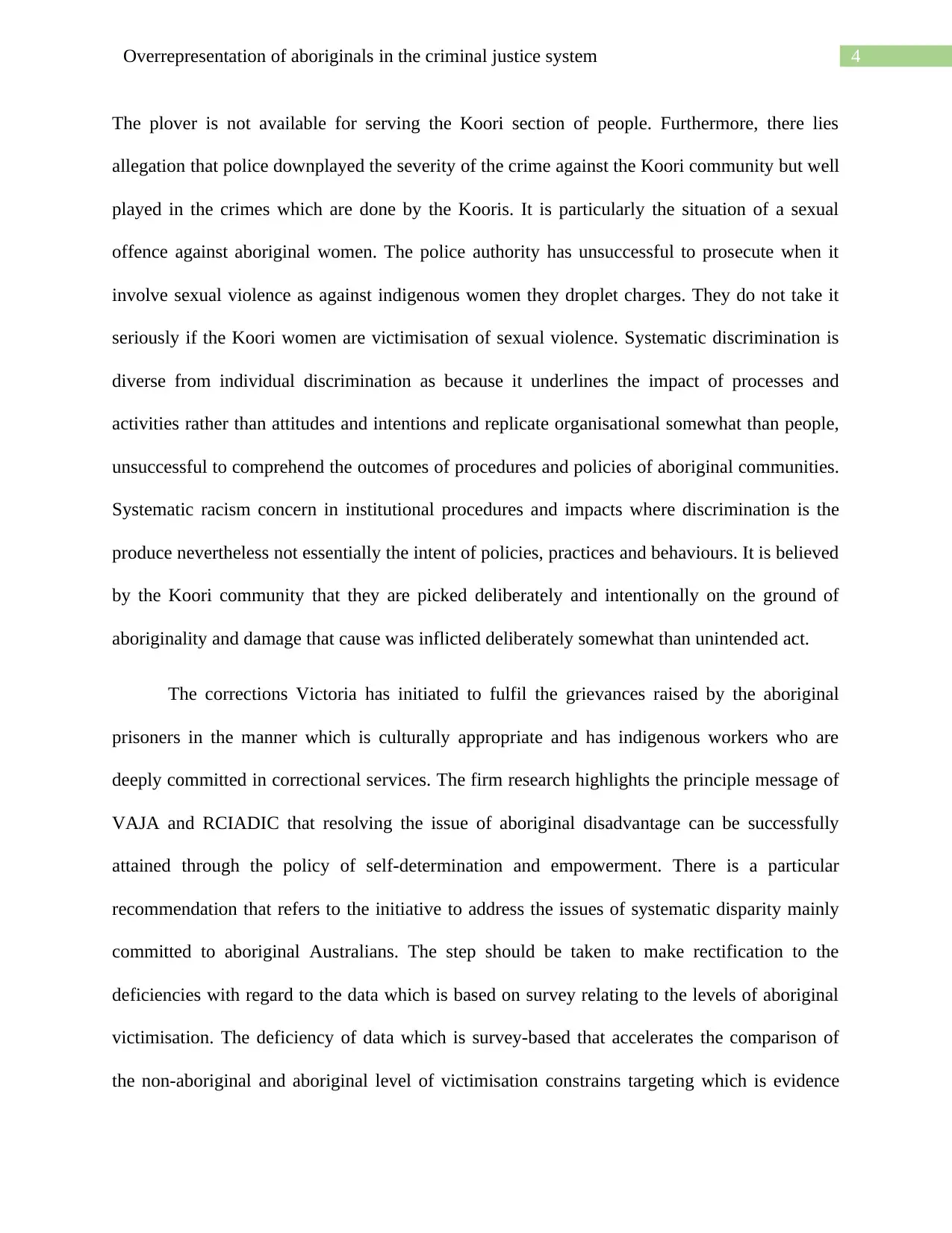
4Overrepresentation of aboriginals in the criminal justice system
The plover is not available for serving the Koori section of people. Furthermore, there lies
allegation that police downplayed the severity of the crime against the Koori community but well
played in the crimes which are done by the Kooris. It is particularly the situation of a sexual
offence against aboriginal women. The police authority has unsuccessful to prosecute when it
involve sexual violence as against indigenous women they droplet charges. They do not take it
seriously if the Koori women are victimisation of sexual violence. Systematic discrimination is
diverse from individual discrimination as because it underlines the impact of processes and
activities rather than attitudes and intentions and replicate organisational somewhat than people,
unsuccessful to comprehend the outcomes of procedures and policies of aboriginal communities.
Systematic racism concern in institutional procedures and impacts where discrimination is the
produce nevertheless not essentially the intent of policies, practices and behaviours. It is believed
by the Koori community that they are picked deliberately and intentionally on the ground of
aboriginality and damage that cause was inflicted deliberately somewhat than unintended act.
The corrections Victoria has initiated to fulfil the grievances raised by the aboriginal
prisoners in the manner which is culturally appropriate and has indigenous workers who are
deeply committed in correctional services. The firm research highlights the principle message of
VAJA and RCIADIC that resolving the issue of aboriginal disadvantage can be successfully
attained through the policy of self-determination and empowerment. There is a particular
recommendation that refers to the initiative to address the issues of systematic disparity mainly
committed to aboriginal Australians. The step should be taken to make rectification to the
deficiencies with regard to the data which is based on survey relating to the levels of aboriginal
victimisation. The deficiency of data which is survey-based that accelerates the comparison of
the non-aboriginal and aboriginal level of victimisation constrains targeting which is evidence
The plover is not available for serving the Koori section of people. Furthermore, there lies
allegation that police downplayed the severity of the crime against the Koori community but well
played in the crimes which are done by the Kooris. It is particularly the situation of a sexual
offence against aboriginal women. The police authority has unsuccessful to prosecute when it
involve sexual violence as against indigenous women they droplet charges. They do not take it
seriously if the Koori women are victimisation of sexual violence. Systematic discrimination is
diverse from individual discrimination as because it underlines the impact of processes and
activities rather than attitudes and intentions and replicate organisational somewhat than people,
unsuccessful to comprehend the outcomes of procedures and policies of aboriginal communities.
Systematic racism concern in institutional procedures and impacts where discrimination is the
produce nevertheless not essentially the intent of policies, practices and behaviours. It is believed
by the Koori community that they are picked deliberately and intentionally on the ground of
aboriginality and damage that cause was inflicted deliberately somewhat than unintended act.
The corrections Victoria has initiated to fulfil the grievances raised by the aboriginal
prisoners in the manner which is culturally appropriate and has indigenous workers who are
deeply committed in correctional services. The firm research highlights the principle message of
VAJA and RCIADIC that resolving the issue of aboriginal disadvantage can be successfully
attained through the policy of self-determination and empowerment. There is a particular
recommendation that refers to the initiative to address the issues of systematic disparity mainly
committed to aboriginal Australians. The step should be taken to make rectification to the
deficiencies with regard to the data which is based on survey relating to the levels of aboriginal
victimisation. The deficiency of data which is survey-based that accelerates the comparison of
the non-aboriginal and aboriginal level of victimisation constrains targeting which is evidence
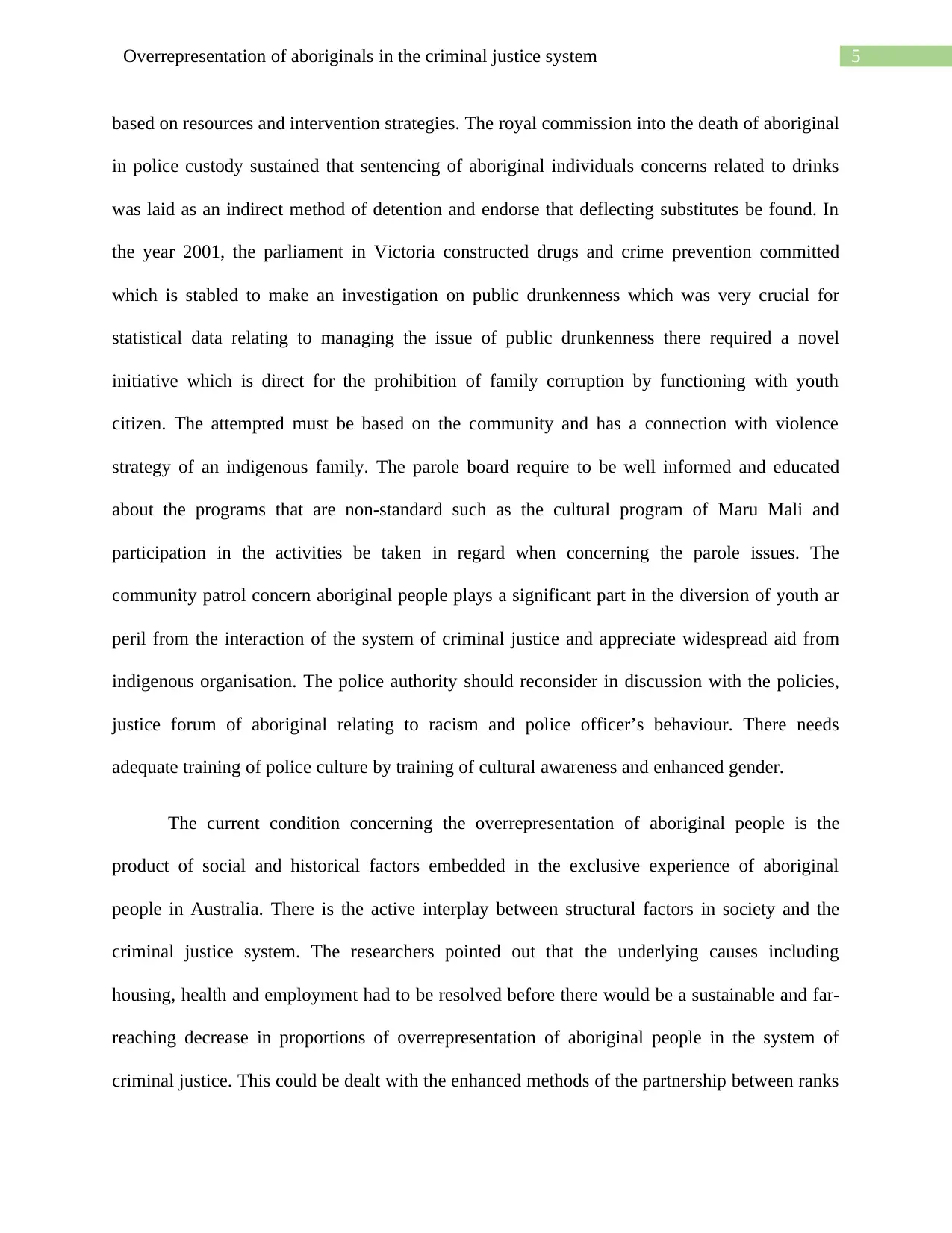
5Overrepresentation of aboriginals in the criminal justice system
based on resources and intervention strategies. The royal commission into the death of aboriginal
in police custody sustained that sentencing of aboriginal individuals concerns related to drinks
was laid as an indirect method of detention and endorse that deflecting substitutes be found. In
the year 2001, the parliament in Victoria constructed drugs and crime prevention committed
which is stabled to make an investigation on public drunkenness which was very crucial for
statistical data relating to managing the issue of public drunkenness there required a novel
initiative which is direct for the prohibition of family corruption by functioning with youth
citizen. The attempted must be based on the community and has a connection with violence
strategy of an indigenous family. The parole board require to be well informed and educated
about the programs that are non-standard such as the cultural program of Maru Mali and
participation in the activities be taken in regard when concerning the parole issues. The
community patrol concern aboriginal people plays a significant part in the diversion of youth ar
peril from the interaction of the system of criminal justice and appreciate widespread aid from
indigenous organisation. The police authority should reconsider in discussion with the policies,
justice forum of aboriginal relating to racism and police officer’s behaviour. There needs
adequate training of police culture by training of cultural awareness and enhanced gender.
The current condition concerning the overrepresentation of aboriginal people is the
product of social and historical factors embedded in the exclusive experience of aboriginal
people in Australia. There is the active interplay between structural factors in society and the
criminal justice system. The researchers pointed out that the underlying causes including
housing, health and employment had to be resolved before there would be a sustainable and far-
reaching decrease in proportions of overrepresentation of aboriginal people in the system of
criminal justice. This could be dealt with the enhanced methods of the partnership between ranks
based on resources and intervention strategies. The royal commission into the death of aboriginal
in police custody sustained that sentencing of aboriginal individuals concerns related to drinks
was laid as an indirect method of detention and endorse that deflecting substitutes be found. In
the year 2001, the parliament in Victoria constructed drugs and crime prevention committed
which is stabled to make an investigation on public drunkenness which was very crucial for
statistical data relating to managing the issue of public drunkenness there required a novel
initiative which is direct for the prohibition of family corruption by functioning with youth
citizen. The attempted must be based on the community and has a connection with violence
strategy of an indigenous family. The parole board require to be well informed and educated
about the programs that are non-standard such as the cultural program of Maru Mali and
participation in the activities be taken in regard when concerning the parole issues. The
community patrol concern aboriginal people plays a significant part in the diversion of youth ar
peril from the interaction of the system of criminal justice and appreciate widespread aid from
indigenous organisation. The police authority should reconsider in discussion with the policies,
justice forum of aboriginal relating to racism and police officer’s behaviour. There needs
adequate training of police culture by training of cultural awareness and enhanced gender.
The current condition concerning the overrepresentation of aboriginal people is the
product of social and historical factors embedded in the exclusive experience of aboriginal
people in Australia. There is the active interplay between structural factors in society and the
criminal justice system. The researchers pointed out that the underlying causes including
housing, health and employment had to be resolved before there would be a sustainable and far-
reaching decrease in proportions of overrepresentation of aboriginal people in the system of
criminal justice. This could be dealt with the enhanced methods of the partnership between ranks
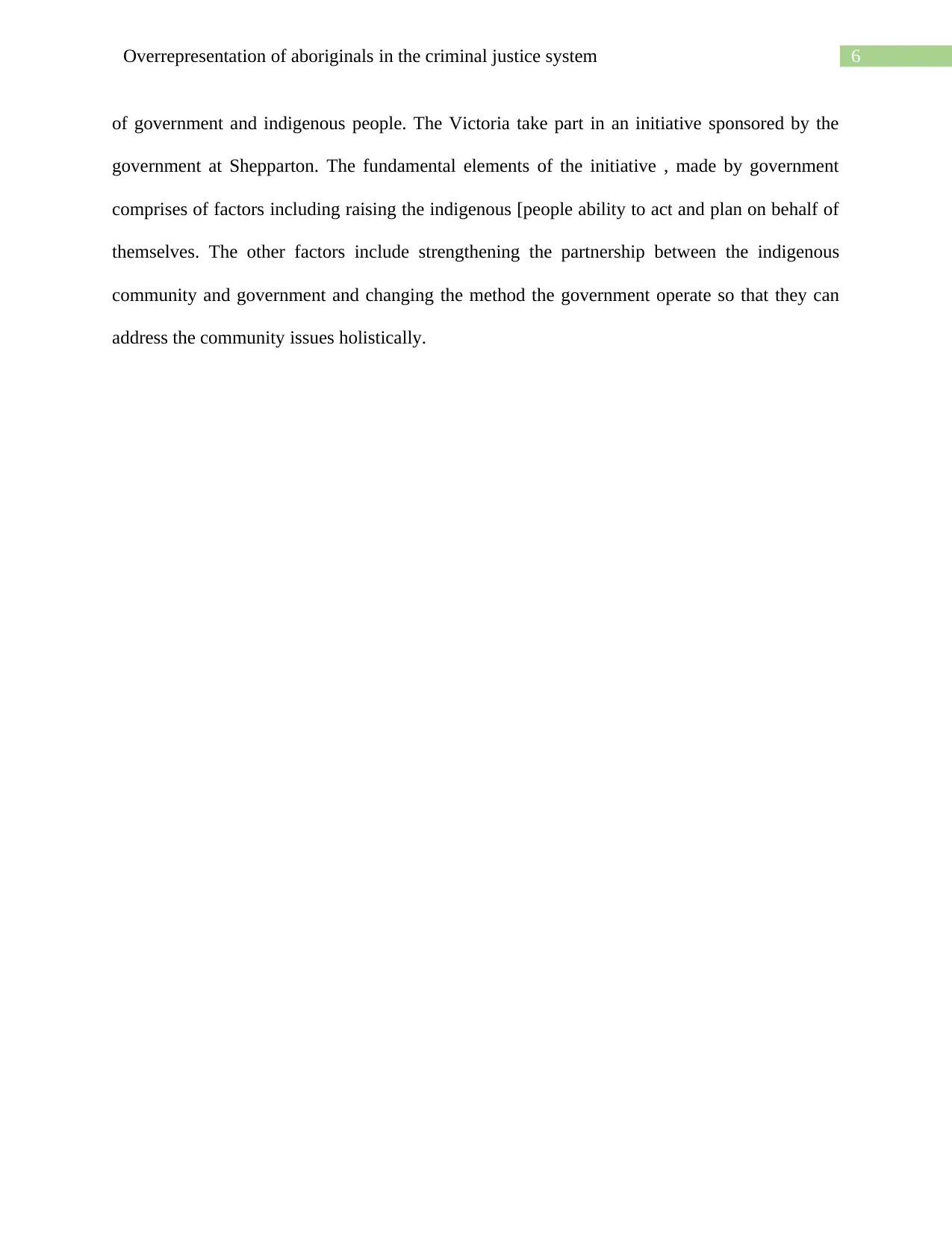
6Overrepresentation of aboriginals in the criminal justice system
of government and indigenous people. The Victoria take part in an initiative sponsored by the
government at Shepparton. The fundamental elements of the initiative , made by government
comprises of factors including raising the indigenous [people ability to act and plan on behalf of
themselves. The other factors include strengthening the partnership between the indigenous
community and government and changing the method the government operate so that they can
address the community issues holistically.
of government and indigenous people. The Victoria take part in an initiative sponsored by the
government at Shepparton. The fundamental elements of the initiative , made by government
comprises of factors including raising the indigenous [people ability to act and plan on behalf of
themselves. The other factors include strengthening the partnership between the indigenous
community and government and changing the method the government operate so that they can
address the community issues holistically.
Paraphrase This Document
Need a fresh take? Get an instant paraphrase of this document with our AI Paraphraser
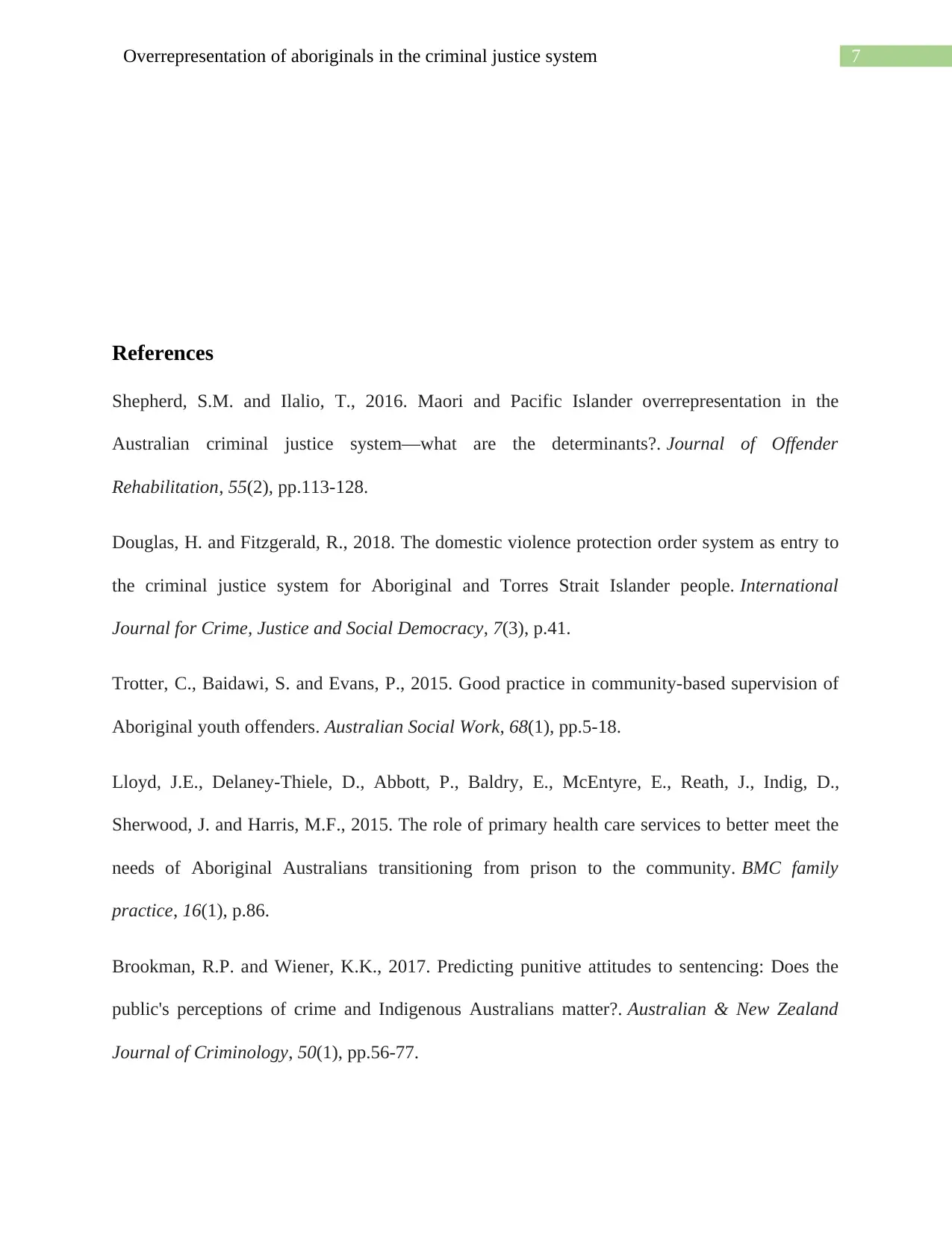
7Overrepresentation of aboriginals in the criminal justice system
References
Shepherd, S.M. and Ilalio, T., 2016. Maori and Pacific Islander overrepresentation in the
Australian criminal justice system—what are the determinants?. Journal of Offender
Rehabilitation, 55(2), pp.113-128.
Douglas, H. and Fitzgerald, R., 2018. The domestic violence protection order system as entry to
the criminal justice system for Aboriginal and Torres Strait Islander people. International
Journal for Crime, Justice and Social Democracy, 7(3), p.41.
Trotter, C., Baidawi, S. and Evans, P., 2015. Good practice in community-based supervision of
Aboriginal youth offenders. Australian Social Work, 68(1), pp.5-18.
Lloyd, J.E., Delaney-Thiele, D., Abbott, P., Baldry, E., McEntyre, E., Reath, J., Indig, D.,
Sherwood, J. and Harris, M.F., 2015. The role of primary health care services to better meet the
needs of Aboriginal Australians transitioning from prison to the community. BMC family
practice, 16(1), p.86.
Brookman, R.P. and Wiener, K.K., 2017. Predicting punitive attitudes to sentencing: Does the
public's perceptions of crime and Indigenous Australians matter?. Australian & New Zealand
Journal of Criminology, 50(1), pp.56-77.
References
Shepherd, S.M. and Ilalio, T., 2016. Maori and Pacific Islander overrepresentation in the
Australian criminal justice system—what are the determinants?. Journal of Offender
Rehabilitation, 55(2), pp.113-128.
Douglas, H. and Fitzgerald, R., 2018. The domestic violence protection order system as entry to
the criminal justice system for Aboriginal and Torres Strait Islander people. International
Journal for Crime, Justice and Social Democracy, 7(3), p.41.
Trotter, C., Baidawi, S. and Evans, P., 2015. Good practice in community-based supervision of
Aboriginal youth offenders. Australian Social Work, 68(1), pp.5-18.
Lloyd, J.E., Delaney-Thiele, D., Abbott, P., Baldry, E., McEntyre, E., Reath, J., Indig, D.,
Sherwood, J. and Harris, M.F., 2015. The role of primary health care services to better meet the
needs of Aboriginal Australians transitioning from prison to the community. BMC family
practice, 16(1), p.86.
Brookman, R.P. and Wiener, K.K., 2017. Predicting punitive attitudes to sentencing: Does the
public's perceptions of crime and Indigenous Australians matter?. Australian & New Zealand
Journal of Criminology, 50(1), pp.56-77.
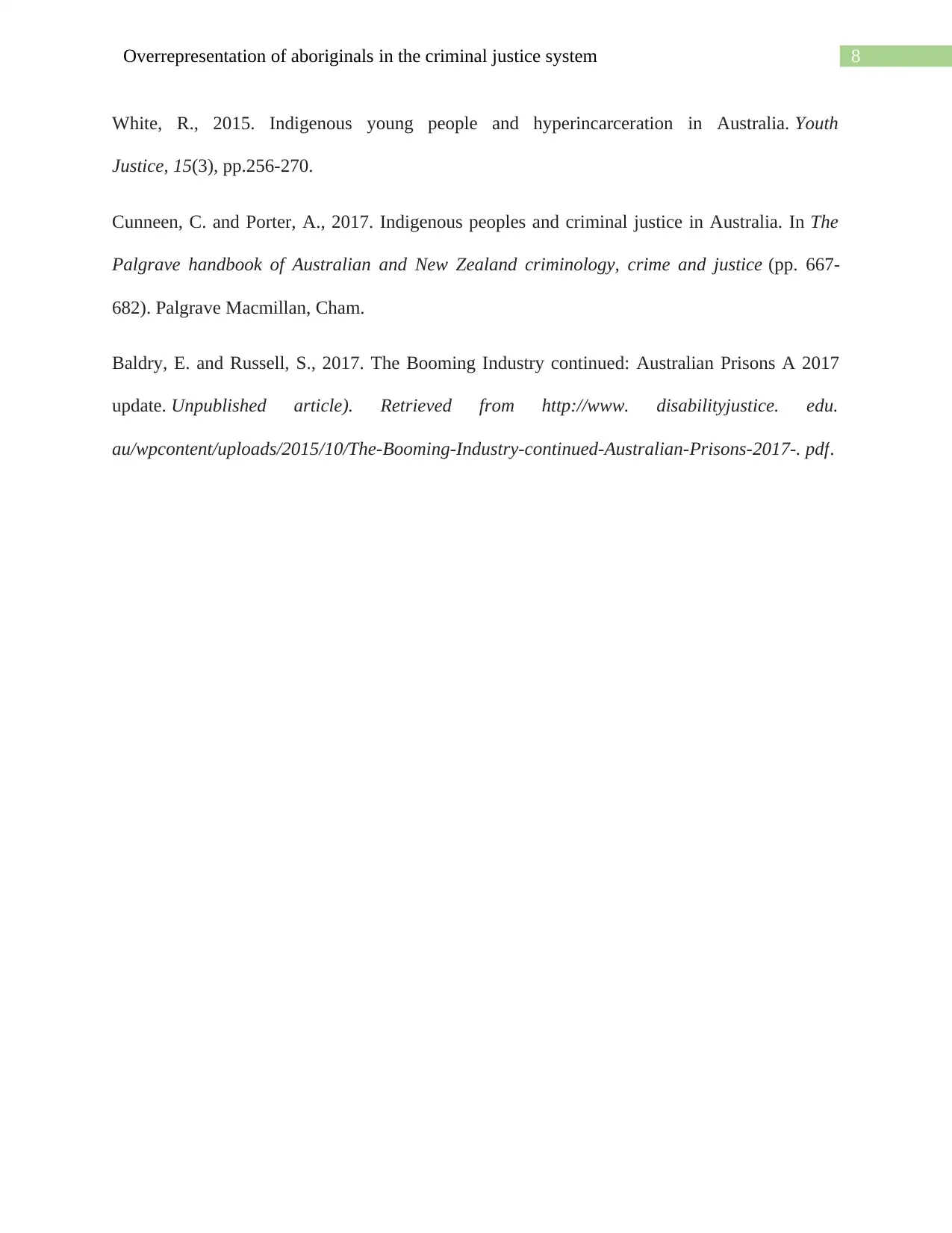
8Overrepresentation of aboriginals in the criminal justice system
White, R., 2015. Indigenous young people and hyperincarceration in Australia. Youth
Justice, 15(3), pp.256-270.
Cunneen, C. and Porter, A., 2017. Indigenous peoples and criminal justice in Australia. In The
Palgrave handbook of Australian and New Zealand criminology, crime and justice (pp. 667-
682). Palgrave Macmillan, Cham.
Baldry, E. and Russell, S., 2017. The Booming Industry continued: Australian Prisons A 2017
update. Unpublished article). Retrieved from http://www. disabilityjustice. edu.
au/wpcontent/uploads/2015/10/The-Booming-Industry-continued-Australian-Prisons-2017-. pdf.
White, R., 2015. Indigenous young people and hyperincarceration in Australia. Youth
Justice, 15(3), pp.256-270.
Cunneen, C. and Porter, A., 2017. Indigenous peoples and criminal justice in Australia. In The
Palgrave handbook of Australian and New Zealand criminology, crime and justice (pp. 667-
682). Palgrave Macmillan, Cham.
Baldry, E. and Russell, S., 2017. The Booming Industry continued: Australian Prisons A 2017
update. Unpublished article). Retrieved from http://www. disabilityjustice. edu.
au/wpcontent/uploads/2015/10/The-Booming-Industry-continued-Australian-Prisons-2017-. pdf.
1 out of 9
Related Documents
Your All-in-One AI-Powered Toolkit for Academic Success.
+13062052269
info@desklib.com
Available 24*7 on WhatsApp / Email
![[object Object]](/_next/static/media/star-bottom.7253800d.svg)
Unlock your academic potential
© 2024 | Zucol Services PVT LTD | All rights reserved.




